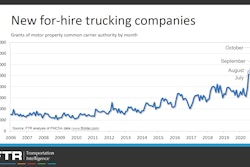Owner-operator Robert Boyle has been recovering from shoulder surgery since June. Boyle, who lives near Dayton, Ohio, is an experienced truck owner, and a longtime confidant of mine when it comes to business issues. We caught up recently and, in the early steps of returning to driving responsibilities (he’s had a driver in his 2007 Peterbilt 387 since July), he’s excited about the future.
Boyle’s no spring chicken, mind you – 68 years old – the Vietnam vet has been a company driver, a mechanical engineer, and project manager for a worldwide corporation. Trucking has been a part of work through much of his history, and as an owner-operator his bread-and-butter since he decided to purchase and a drive truck again after retirement.
 Owner-operator Robert Boyle and his 2007 Peterbilt 387
Owner-operator Robert Boyle and his 2007 Peterbilt 387Once upon a time, I told him, “You’re too intelligent for this business.” He just scoffed at that. His natural curiosity and inner drive to improve are gifts — he questions everything, looking for ways to improve.
The engineer comes out in him when we talk — he’s very much about precision, and what the numbers are saying. As he and I discussed the current freight market and changes likely coming for the first quarter, we agreed owners cannot just sit back and wait to adjust our cost of goods sold, and that cost for many an owner’s purchases are going to rise.

The electronic logging device mandate is still driving some of this. I’d encourage you to reflect on Dec. 18, 2017, the day the mandate first went into effect. The immediate impact was a reduction in truck capacity, or at the very least a strong perception of a reduction. In my humble opinion, it could easily have resulted in 10% overall fewer available trucks as everyone struggled to more closely align available hours with just where those hours were needed.
Rates, of course, around that time went up, squeezing customers and their budgets.
But the other driver is the increased cost of truck ownership, generally, over the long- and short-term. As demand for trucks and trailers increased around the time of the mandate, it was a sellers’ market. If you remember, many drivers were stunned by increases in labor rates and parts, as well as little things like tolls, food and parking.
Now flip the page to the second quarter of 2019 – the entire market seemed to adjust. Freight customers had put in place more stable contracts to help mitigate the spot market surge. The train had left the station and was barreling ahead toward a new balance then — bam! – COVID hit and people asked what the hell just happened. Fear took hold, and the rules had been changed again.
The federal government steps in, throwing what’s perceived as free money at individuals and businesses though the various stimulus programs and business-focused PPP and EIDL loans, programs that are still mired in a degree of uncertainty as to just how they will end.
Today, Congress is voting on yet more stimulus, delivering opportunities, sure, yet further uncertainty with a promise of more capital being injected into the economy with the new Congress next year. I wouldn’t discount unpredictable, future policy changes out of Washington, through regulations or income taxes. The business of business is always changing and can seem to take the joy out of driving, at times. Stay in close communication with your tax preparer – knowledge about, enabling preparation for, what’s ahead can breed peace of mind.
Robert and I often enough talk about big trends like this and where they might turn or end up, but our recent conversation was more focused on what any truck owner should know backwards and forwards: The cost of hauling. With an eye toward benchmarking his own operation, he asked me what I thought the average was now? Without hesitation, I said $1.70 plus or minus a few cents. That included the salary necessary for the driver. His cost had been $1.67, he said, but before our talk ended, he recalculated some expenses in the last 30 days and raised this to $1.80 per mile for his business, including $0.55-per-mile pay to himself.
Robert does not have a truck payment to figure into that cost.
I’m foreseeing yet another significant shift in the cost of business. And there’s more than one thing influencing this in my mind. Profits have been surprisingly strong for the publicly traded companies. Look at the Dow Jones Transportation Average, the quarterly stock reports, and the reports of owner-operator incomes.
Take notice there has been a noticeable increase in new authorities, along with interest in purchasing trucks and trailers. Look at the demand to hire drivers. What’s your takeaway?
As profit potential increases, so does the cost of entry and the cost of your inputs. We are likely going to have increases in fuel and fuel tax costs again. I’ve seen many stories related to increases in tolls — somewhat usual this time of year — and the cycle continues upward in an inflationary pattern.
You cannot afford to wait until well after increases truly take hold to adjust your own cost basis, and rates, accordingly. Neither can you afford to just trade dollar for dollar with the increase in expenses.
Case in point: the pesky problem of tolls in particular. Too many of us just automatically reject new opportunities from Pennsylvania up through the Northeast to avoid them. Yet keeping track of the real cost of tolls – and adjusting rates accordingly – has never been easier. Automatic transponder-type toll collection systems allow for that ease, yet they can also present an out-of-sight, out-of-mind trap, making it less likely that we will access our accounts outside tax time to make a real-cost assessment for any particular load serviced, let alone take that cost into account before negotiating the load.
On the Pennsylvania Turnpike, additional cost per mile paying cash for tolls can be $1.15 per mile, $0.80 with the transponder. If you normally figure a cost of $1.70 per mile to cover your expenses and pay, go on and bump that up to $2.50-$2.85 per mile for those tolled Pennsylvania miles along the route.
Have a good awareness of and estimate for what your real costs are going to be. Then calculate everything as best you can along with all your other expenses before accepting a load tender – it’s vital to your ability to survive and thrive in business.
(Here’s one link to assist you in calculating your toll cost.)










